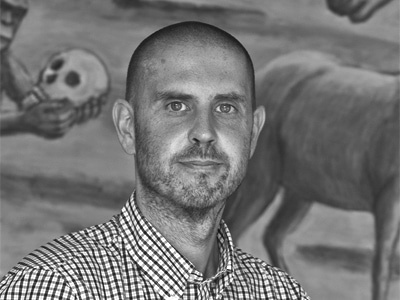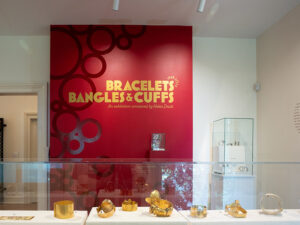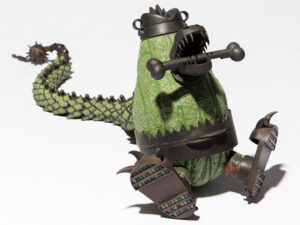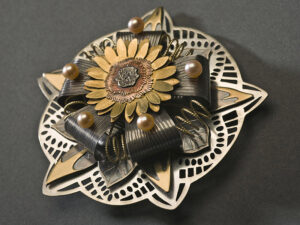Bellevue Arts Museum (BAM) has undertaken a series of important surveys of American contemporary jewelers over the past few years. These include Lisa Gralnick: The Gold Standard in 2010 and Knitted, Knotted, Twisted & Twined: The Jewelry of Mary Lee Hu in 2012. (You can read reviews of both exhibitions on the AJF website. The museum has also been a frequent American venue for national and international touring exhibitions of contemporary jewelry. I had the opportunity to speak with Stefano Catalani, Director of Curatorial Affairs/Artistic Director, in October 2011. We talked about his institution and the role of contemporary jewelry in the museum’s activities.
Damian Skinner: Your museum doesn’t have a contemporary jewelry collection, but you do a lot of work with jewelry.
Stefano Catalani: That is correct. We’re a non-collecting institution.
Has the museum ever had a collection?
Stefano Catalani: Yes. It was de-accessioned around 1998. Ultimately, most of the collection ended up at the Tacoma Art Museum in Tacoma, Washington. An agreement between the two institutions grants us free access to the collection. We can borrow any object from their collection, whether or not it came from BAM. That’s been useful in the past six years.
The decision to part with the collection was made at the time when the organization was moving from an older venue to the current building. The space was designed by Steven Holl to host a Kunsthalle-type museum with always-changing exhibitions. Shedding the skin of a permanent collection made us able to seize the moment of the contemporary art world. We would like to collect some day, although honestly, in these times of economic downturn, we are happy not to have the overhead of maintaining a collection. If we were to become a collecting institution, we would have to solve some logistical problems. In fact, the building was designed without appropriate space for storing and managing a collection.
What was the thinking behind transforming the museum from a collections-based organization to a non-collecting museum?
Stefano Catalani: I think at that time the cost associated with maintaining the collection was too burdensome for the institution, and the museum wanted to become financially leaner. Then, there was already this exciting idea of building the new venue and changing the focus of the museum’s mission. So, I believe this also informed the decision of the board.
Obviously, there has been another change. You are no longer focused on new media and contemporary art practices. Why did that happen?
Stefano Catalani: When the museum moved into this new facility there was a shift in the mission. The institution decided to focus more on cutting edge contemporary art. Ultimately, this change did not resonate with the community that had supported the museum from its inception in the mid 1970s. The original organization was born out of the arts and crafts fair, which turned 66 this year. There was a strong tradition of craft, craftsmanship, skill, and functional objects in the DNA of the institution.
In September 2003, the decision was made to close the museum, to pause, to take a break, and to have a moment of reflection. At that point, the board of trustees went back to the constituency and the community and asked what they wanted the museum to be. The response was to go back to the roots, to go back to where the museum came from in first place.
Michael W. Monroe was hired as Executive Director and Chief Curator in 2004. He came from the Renwick Gallery, part of the National Museum of American Art in Washington DC, with 30 years of experience in and deep knowledge of the fields of craft and design. Michael Monroe strived to make the Bellevue Arts Museum the northwest center for the exploration of art, craft, and design through exhibitions, educational programs, and partnerships with an emphasis on Northwest artists.
That mission overlaps with the Tacoma Art Museum in some ways.
Stefano Catalani: Partially. Tacoma Art Museum definitely has a focus on Northwest art, and because craft is an integral part of the past and present visual and cultural landscape of the Northwest, the two museums overlap. I think this is good thing, a richness that is offered through different perspectives. And we collaborate.
Did the collection that was de-accessioned have a specific focus?
Stefano Catalani: It included both craft and fine art. For example, it included works by Howard Kottler. Kottler is a seminal figure in bringing postmodernism into the ceramics world. He blazed a trail both as a potter and sculptor in the Northwest and in America. The collection also included paintings and sculptures by many regional artists—mixture of things.
Tell me how you came to be involved with the museum.
Stefano Catalani: I started working here in 2005, a month before the most recent incarnation of the museum opened its doors. Before, I worked as the director of a commercial gallery in Seattle for about a year and as a freelance curator.
Did you always have an interest in craft and design?
Stefano Catalani: No, actually. Around 2003 I became interested in artists whose work reclaims the visual and material language of craft in order to investigate their own cultural identity through a recovery of that tradition and its signs and symbols. I was fascinated by the idea of craft as a sign, the idea of craft as a language (which is a sequence of signs) defined by the information it carries with it. At that time, I was writing about Chinese-Australian or Chinese-Canadian artists. I believe Michael Monroe saw my interest as a complement to the more traditional forms and interpretations of craft he was planning to showcase at BAM. This is actually what I’ve been exploring in the last seven years at the museum.
How does contemporary jewelry fit within your museum’s intention to cover art, craft, and design?
Stefano Catalani: I think jewelry is an important form of artistic and cultural expression. It is information delivered through a language of lines in metals and other materials. Jewelry fits within the traditional field of craft—skill has to be harnessed to deliver a product that is functional and functionally crafted—but at the same time, by embodying and delivering meaning, it belongs to the field of art. Featuring jewelry has been quite successful for us. There’s been a strong response to jewelry shows. Jewelry is definitely popular.
Why do you think that is? What is the nature of its popularity?
Stefano Catalani: It’s about objects, things that you can touch. It doesn’t have the sacredness of a painting or sculpture, which demands distance and reverence. In my opinion, jewelry’s function as body ornament lowers our threshold of reverence. Its perception as an object to wear provides an entry point to its sculptural dimension and aesthetic and cultural values. So, there is the opening to another meaning, another sphere.
I come from Italy, a country where paintings and sculptures are in churches, and there is a reverence for them both as cult objects and objects of art. The institution of the museum is often like a church. Museums are temples where we worship art in all its forms. There is this sense of sacredness and reverence that comes into play when one is in front of an image. You almost feel you have to kneel.
I feel a museum that focuses on craft can take advantage of that particular lack of distance and sacred reverence. Unfortunately, we still have to put jewelry under a vitrine, but I think jewelry is popular because everyone can wear it or imagine they are wearing it, and everyone can make a statement about his or her identity or persona or whatever he or she wants to be.
What made you decide to do a series of solo retrospectives of American jewelers?
Stefano Catalani: From an organizational point of view, dealing with one artist’s work is easier. There is the idea of following the evolution of the artist’s work over a certain period of time or over several bodies of work. A group show requires more time to hone the idea, the theme that brings everything together.
We are a small museum. Although we pride ourselves with being nimble, we remain a small organization with limited personnel. There’s not always time to come up with and flesh out good ideas for group shows. Therefore, we supplement our efforts with traveling exhibits. We hosted Think Twice: New Latin American Jewelry, and a few years ago we took Women’s Tales, an exhibition of four leading Israeli jewelers.
In terms of solo exhibitions, we have featured the work of Bruce Metcalf, Lisa Gralnick, Ron Ho, and Mary Lee Hu. (The latter three were internally curated.) With Ron Ho and Mary Lee Hu, the idea was to celebrate important figures in the development of contemporary jewelry in the Northwest.
Tell me about the staff who are involved in curatorial activities.
Stefano Catalani: It’s a small staff. I am the director of curatorial affairs and artistic director, and I am responsible for implementing the museum’s mission and for leading the curatorial department. I share the leadership of the museum with the managing director. Nora Atkinson holds one curatorial position. (She curated the Lisa Gralnick exhibit.) We also have one registrar, a head preparator, and a temporary crew of five or six people to install the exhibitions. To complete the picture, we have an education curator and a part-time youth and family education coordinator.
How many shows a year do you do?
Stefano Catalani: Eight to ten. There’s not a recipe. It depends on various factors. Usually, the first exhibitions to be scheduled on the calendar are the traveling ones. Then, we juggle the internal projects to fit around the traveling shows. We strive for a half-and-half ratio of in-house to traveling exhibitions.
Contemporary jewelry seems to have a rich history in the Pacific Northwest. Can you tell me about that?
Stefano Catalani: The metals program at the University of Washington was very strong for many decades. It started with Ruth Pennington who was a modernist jeweler. Then, Ramona Solberg came. She was a force of nature for sure and the mentor and teacher of Ron Ho. The tradition continued with Mary Lee Hu, John Marshall, Andy Cooperman, Laurie Hall, and Nancy Warden. Through the physical and cultural environ of the metals program, which was dissolved in 2006, there was a creative continuity at the University of Washington. Metalsmiths and jewelers handed down their visions and legacies to their students, fostering creativity in service of their vision.
The Pacific Northwest has a very subdued cultural attitude toward ostentation and public display. They say it is a legacy of the Scandinavian immigrants to this region. And yet, for a place where simplicity and lack of adornment seem to be held as moral virtues, there’s such an incredible wealth and tradition of jewelers and metalsmiths!
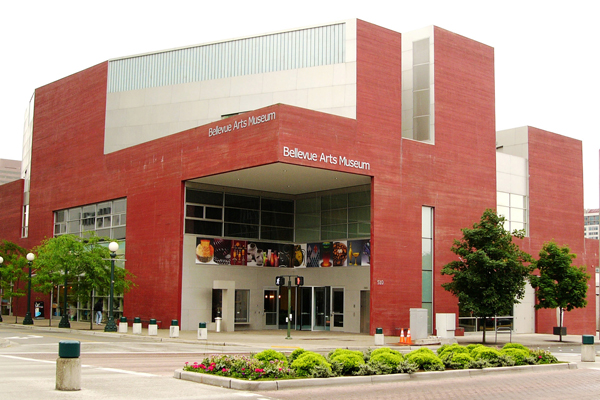
Damian Skinner: Your museum doesn’t have a contemporary jewelry collection, but you do a lot of work with jewelry.
Stefano Catalani: That is correct. We’re a non-collecting institution.
Has the museum ever had a collection?
Stefano Catalani: Yes. It was de-accessioned around 1998. Ultimately, most of the collection ended up at the Tacoma Art Museum in Tacoma, Washington. An agreement between the two institutions grants us free access to the collection. We can borrow any object from their collection, whether or not it came from BAM. That’s been useful in the past six years.
The decision to part with the collection was made at the time when the organization was moving from an older venue to the current building. The space was designed by Steven Holl to host a Kunsthalle-type museum with always-changing exhibitions. Shedding the skin of a permanent collection made us able to seize the moment of the contemporary art world. We would like to collect some day, although honestly, in these times of economic downturn, we are happy not to have the overhead of maintaining a collection. If we were to become a collecting institution, we would have to solve some logistical problems. In fact, the building was designed without appropriate space for storing and managing a collection.
What was the thinking behind transforming the museum from a collections-based organization to a non-collecting museum?
Stefano Catalani: I think at that time the cost associated with maintaining the collection was too burdensome for the institution, and the museum wanted to become financially leaner. Then, there was already this exciting idea of building the new venue and changing the focus of the museum’s mission. So, I believe this also informed the decision of the board.
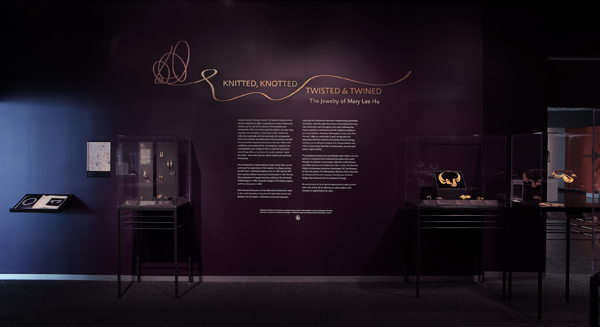
Obviously, there has been another change. You are no longer focused on new media and contemporary art practices. Why did that happen?
Stefano Catalani: When the museum moved into this new facility there was a shift in the mission. The institution decided to focus more on cutting edge contemporary art. Ultimately, this change did not resonate with the community that had supported the museum from its inception in the mid 1970s. The original organization was born out of the arts and crafts fair, which turned 66 this year. There was a strong tradition of craft, craftsmanship, skill, and functional objects in the DNA of the institution.
In September 2003, the decision was made to close the museum, to pause, to take a break, and to have a moment of reflection. At that point, the board of trustees went back to the constituency and the community and asked what they wanted the museum to be. The response was to go back to the roots, to go back to where the museum came from in first place.
Michael W. Monroe was hired as Executive Director and Chief Curator in 2004. He came from the Renwick Gallery, part of the National Museum of American Art in Washington DC, with 30 years of experience in and deep knowledge of the fields of craft and design. Michael Monroe strived to make the Bellevue Arts Museum the northwest center for the exploration of art, craft, and design through exhibitions, educational programs, and partnerships with an emphasis on Northwest artists.
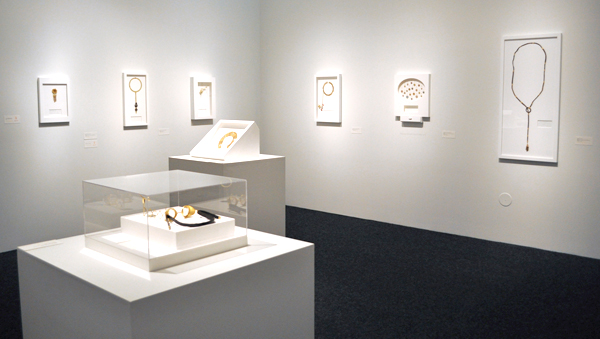
Stefano Catalani: Partially. Tacoma Art Museum definitely has a focus on Northwest art, and because craft is an integral part of the past and present visual and cultural landscape of the Northwest, the two museums overlap. I think this is good thing, a richness that is offered through different perspectives. And we collaborate.
Did the collection that was de-accessioned have a specific focus?
Stefano Catalani: It included both craft and fine art. For example, it included works by Howard Kottler. Kottler is a seminal figure in bringing postmodernism into the ceramics world. He blazed a trail both as a potter and sculptor in the Northwest and in America. The collection also included paintings and sculptures by many regional artists—mixture of things.
Tell me how you came to be involved with the museum.
Stefano Catalani: I started working here in 2005, a month before the most recent incarnation of the museum opened its doors. Before, I worked as the director of a commercial gallery in Seattle for about a year and as a freelance curator.
Did you always have an interest in craft and design?
Stefano Catalani: No, actually. Around 2003 I became interested in artists whose work reclaims the visual and material language of craft in order to investigate their own cultural identity through a recovery of that tradition and its signs and symbols. I was fascinated by the idea of craft as a sign, the idea of craft as a language (which is a sequence of signs) defined by the information it carries with it. At that time, I was writing about Chinese-Australian or Chinese-Canadian artists. I believe Michael Monroe saw my interest as a complement to the more traditional forms and interpretations of craft he was planning to showcase at BAM. This is actually what I’ve been exploring in the last seven years at the museum.
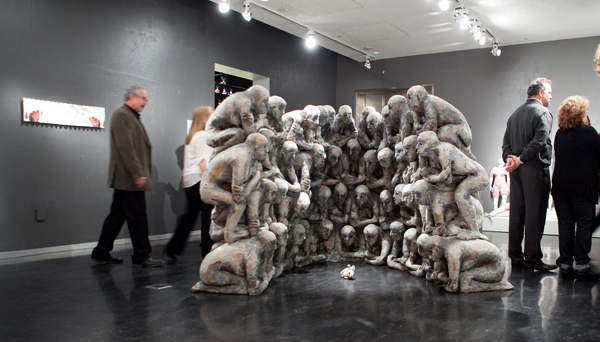
Stefano Catalani: I think jewelry is an important form of artistic and cultural expression. It is information delivered through a language of lines in metals and other materials. Jewelry fits within the traditional field of craft—skill has to be harnessed to deliver a product that is functional and functionally crafted—but at the same time, by embodying and delivering meaning, it belongs to the field of art. Featuring jewelry has been quite successful for us. There’s been a strong response to jewelry shows. Jewelry is definitely popular.
Why do you think that is? What is the nature of its popularity?
Stefano Catalani: It’s about objects, things that you can touch. It doesn’t have the sacredness of a painting or sculpture, which demands distance and reverence. In my opinion, jewelry’s function as body ornament lowers our threshold of reverence. Its perception as an object to wear provides an entry point to its sculptural dimension and aesthetic and cultural values. So, there is the opening to another meaning, another sphere.
I come from Italy, a country where paintings and sculptures are in churches, and there is a reverence for them both as cult objects and objects of art. The institution of the museum is often like a church. Museums are temples where we worship art in all its forms. There is this sense of sacredness and reverence that comes into play when one is in front of an image. You almost feel you have to kneel.
I feel a museum that focuses on craft can take advantage of that particular lack of distance and sacred reverence. Unfortunately, we still have to put jewelry under a vitrine, but I think jewelry is popular because everyone can wear it or imagine they are wearing it, and everyone can make a statement about his or her identity or persona or whatever he or she wants to be.
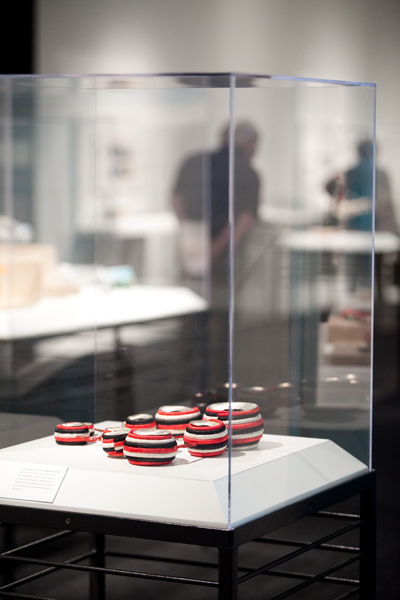
Stefano Catalani: From an organizational point of view, dealing with one artist’s work is easier. There is the idea of following the evolution of the artist’s work over a certain period of time or over several bodies of work. A group show requires more time to hone the idea, the theme that brings everything together.
We are a small museum. Although we pride ourselves with being nimble, we remain a small organization with limited personnel. There’s not always time to come up with and flesh out good ideas for group shows. Therefore, we supplement our efforts with traveling exhibits. We hosted Think Twice: New Latin American Jewelry, and a few years ago we took Women’s Tales, an exhibition of four leading Israeli jewelers.
In terms of solo exhibitions, we have featured the work of Bruce Metcalf, Lisa Gralnick, Ron Ho, and Mary Lee Hu. (The latter three were internally curated.) With Ron Ho and Mary Lee Hu, the idea was to celebrate important figures in the development of contemporary jewelry in the Northwest.
Tell me about the staff who are involved in curatorial activities.
Stefano Catalani: It’s a small staff. I am the director of curatorial affairs and artistic director, and I am responsible for implementing the museum’s mission and for leading the curatorial department. I share the leadership of the museum with the managing director. Nora Atkinson holds one curatorial position. (She curated the Lisa Gralnick exhibit.) We also have one registrar, a head preparator, and a temporary crew of five or six people to install the exhibitions. To complete the picture, we have an education curator and a part-time youth and family education coordinator.
How many shows a year do you do?
Stefano Catalani: Eight to ten. There’s not a recipe. It depends on various factors. Usually, the first exhibitions to be scheduled on the calendar are the traveling ones. Then, we juggle the internal projects to fit around the traveling shows. We strive for a half-and-half ratio of in-house to traveling exhibitions.

Stefano Catalani: The metals program at the University of Washington was very strong for many decades. It started with Ruth Pennington who was a modernist jeweler. Then, Ramona Solberg came. She was a force of nature for sure and the mentor and teacher of Ron Ho. The tradition continued with Mary Lee Hu, John Marshall, Andy Cooperman, Laurie Hall, and Nancy Warden. Through the physical and cultural environ of the metals program, which was dissolved in 2006, there was a creative continuity at the University of Washington. Metalsmiths and jewelers handed down their visions and legacies to their students, fostering creativity in service of their vision.
The Pacific Northwest has a very subdued cultural attitude toward ostentation and public display. They say it is a legacy of the Scandinavian immigrants to this region. And yet, for a place where simplicity and lack of adornment seem to be held as moral virtues, there’s such an incredible wealth and tradition of jewelers and metalsmiths!
